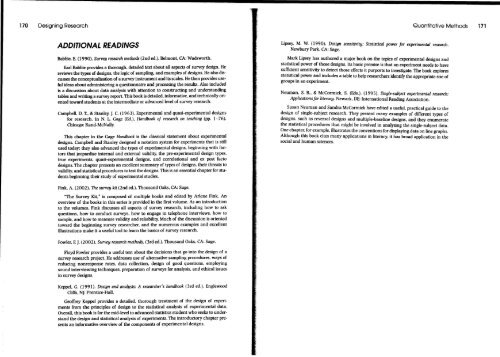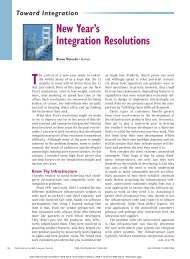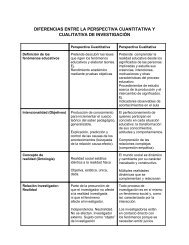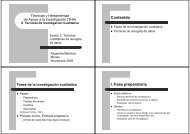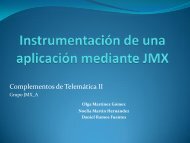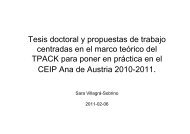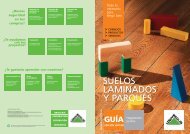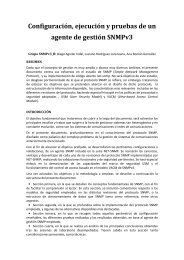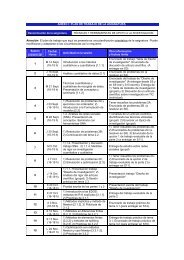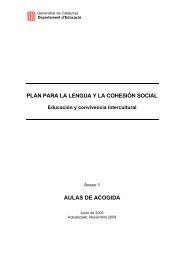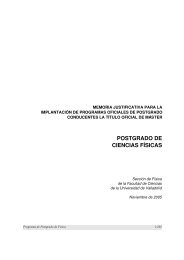Research Questions and Hypotheses
Research Questions and Hypotheses
Research Questions and Hypotheses
Create successful ePaper yourself
Turn your PDF publications into a flip-book with our unique Google optimized e-Paper software.
170 Designing <strong>Research</strong> Quantitative Methods 171<br />
ADDITIONAL READINGS<br />
Babbie, E. (1990). Survey research methods (2nd ed.). Belmont, CA: Wadsworth.<br />
Earl Babbie provides a thorough, detailed text about all aspects of survey design. He<br />
reviews the types of designs, the logic of sampling, <strong>and</strong> examples of designs. He also discusses<br />
the conceptualization of a survey instrument <strong>and</strong> its scales. He then provides useful<br />
ideas about administering a questionnaire <strong>and</strong> processing the results. Also included<br />
is a discussion about data analysis with attention to constructing <strong>and</strong> underst<strong>and</strong>ing<br />
tables <strong>and</strong> writing a survey report. This book is detailed, informative, <strong>and</strong> technically oriented<br />
toward students at the intermediate or advanced level of survey research.<br />
Campbell, D. T., & Stanley, J. C. (1963). Experimental <strong>and</strong> quasi-experimental designs<br />
for research. In N. L. Gage (Ed.), H<strong>and</strong>book of research on teaching (pp. 1-76).<br />
Chicago: R<strong>and</strong>-McNally.<br />
This chapter in the Gage H<strong>and</strong>book is the classical statement about experimental<br />
designs. Campbell <strong>and</strong> Stanley designed a notation system for experiments that is still<br />
used today; they also advanced the types of experimental designs, beginning with factors<br />
that jeopardize interna! <strong>and</strong> external validity, the pre-experimental design types,<br />
true experiments, quasi-experimental designs, <strong>and</strong> correlational <strong>and</strong> ex post facto<br />
designs. The chapter presents an excellent summary of types of designs, their threats to<br />
validity, <strong>and</strong> statistical procedures to test the designs. This is an essential chapter for students<br />
beginning their study of experimental studies.<br />
Lipsey, M. W (1990). Design sensitivity: Statistical power for experimental research.<br />
Newbury Park, CA: Sage.<br />
Mark Lipsey has authored a major book on the topics of experimental designs <strong>and</strong><br />
statistical power of those designs. Its basic premise is that an experiment needs to have<br />
sufficient sensitivity to detect those effects it purports to investígate. The book explores<br />
statistical power <strong>and</strong> includes a table to help researchers identify the appropriate size of<br />
groups in an experiment.<br />
Neuman, S. B., & McCormick, S. (Eds.). (1995). Single-subject experimental research:<br />
Applications for literacy. Newark, DE: International Reading Association.<br />
Susan Neuman <strong>and</strong> S<strong>and</strong>ra McCormick have edited a useful, practical guide to the<br />
design of single-subject research. They present many examples of different types of<br />
designs, such as reversal designs <strong>and</strong> multiple-baseline designs, <strong>and</strong> they enumerate<br />
the statistical procedures that might be involved in analyzing the single-subject data.<br />
One chapter, for example, illustrates the conventions for displaying data on line graphs.<br />
Although this book cites many applications in literacy, it has broad application in the<br />
social <strong>and</strong> human sciences.<br />
Fink, A. (2002). The survey kit (2nd ed.). Thous<strong>and</strong> Oaks, CA: Sage.<br />
"The Survey Kit," is composed of multiple books <strong>and</strong> edited by Arlene Fink. An<br />
overview of the books in this series is provided in the first volume. As an introduction<br />
to the volumes, Fink discusses all aspects of survey research, including how to ask<br />
questions, how to conduct surveys, how to engage in telephone interviews, how to<br />
sample, <strong>and</strong> how to measure validity <strong>and</strong> reliability. Much of the discussion is oriented<br />
toward the beginning survey researcher, <strong>and</strong> the numerous examples <strong>and</strong> excellent<br />
illustrations make it a useful tool to learn the basics of survey research.<br />
Fowler, F. J. (2002). Survey research methods. (3rd ed.). Thous<strong>and</strong> Oaks, CA: Sage.<br />
Floyd Fowler provides a useful text about the decisions that go into the design of a<br />
survey research project. He addresses use of alternative sampling procedures, ways of<br />
reducing nonresponse rates, data collection, design of good questions, employing<br />
sound interviewing techniques, preparation of surveys for analysis, <strong>and</strong> ethical issues<br />
in survey designs.<br />
Keppel, G. (1991). Design <strong>and</strong> analysis: A researcher's h<strong>and</strong>book (3rd ed.). Englewood<br />
Cliffs, NJ: Prentice-Hall.<br />
Geoffrey Keppel provides a detailed, thorough treatment of the design of experiments<br />
from the principies of design to the statistical analysis of experimental data.<br />
Overall, this book is for the mid-level to advanced statistics student who seeks to underst<strong>and</strong><br />
the design <strong>and</strong> statistical analysis of experiments. The introductory chapter presents<br />
an informative overview of the components of experimental designs.


